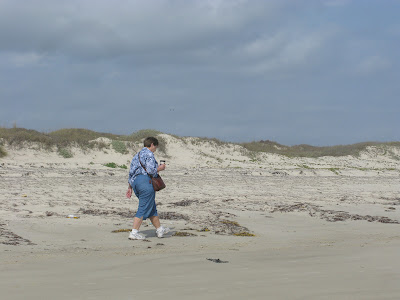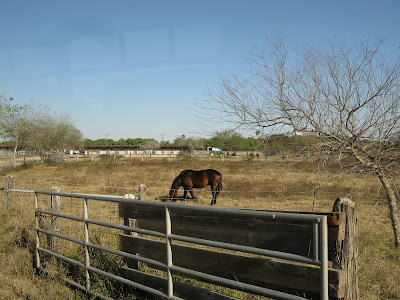Texas is on the gulf of Mexico. A couple of miles off shore sits the barrier islands which protect the coastal towns from the open water of the gulf. These long narrow islands are called the San Padre Islands. There are only a few places where you can get from the mainland to the San Padres; this is the causeway from Corpus Christi to South San Padre.
Although there are towns and buildings on the islands, most of them are part of the National Park System and are kept natural. The centre of the islands are mostly marshes and grasses with beautiful beaches along the shore lines.
The beaches are very wide and flat and go on for hundreds of miles. The waves are noticeably rougher of the gulf side of the barrier islands than on the protected shoreline of the mainland.
We walked down the beach for a few miles and had it pretty well to ourselves. This was the warmest and least windy day we've seen since early December and the walk was very pleasant.
The beach ends at these big sand dunes which are probably 20 feet high. The great thing about them is they provide great shelter if you've been drinking coffee all morning.
A lot of the beach is not open to cars but miles of driving beaches let you get all the sand and salt you want on your car. The sand is like flour and it was impossible to get in and out of the car without bringing in lots of sand.
A bridge lets you drive from South San Padre to Mustang Island. Driving north on this island takes you to Port Aransas which is the most northerly you can go on the barrier islands. This is a real tourist town with beach wear huts to restaurants. You can rent dune buggies or horses to ride on the beach. I don't know if they give you a shovel as well. This park is the last stop on the island and had lots of hikers and fishermen enjoying the day. We watched dolphins swim by and lots of boats cruising around. A lovely spot.
To get off Mustang Island back to the mainland, you need to take a ferry. Although this channel isn't too wide and a bridge would easily span it, it needs to be open for the oil tankers. Out in the gulf, hundreds of oil rigs are taking out oil which is transferred to oil tankers who take it to shore in Corpus to the refineries there. These tankers are moving through this channel all the time so its easier to use ferries which can stop and let the tankers through. The ferries are free; imagine that in Ontario!
We got the front view on the ferry. Pretty impressive isn't it. The trip only took about 10 minutes and was surprisingly bumpy. I guess with multiple ferries going by the wakes were large enough to rock the boat. Then we're back on the mainland with a 30 minute drive back home. Always wanted to see the San Padres.












































